 Traduzca esta página al español
usar FreeTranslation.com
Traduzca esta página al español
usar FreeTranslation.com 
 Traduire Cette Page A Français
utilisation FreeTranslation.com
Traduire Cette Page A Français
utilisation FreeTranslation.com 
 Übersetzen Sie Diese Seite Zu Deutsch
Gebrauch FreeTranslation.com
Übersetzen Sie Diese Seite Zu Deutsch
Gebrauch FreeTranslation.com 
 The image on the Shroud of Turin is not Jesus
The image on the Shroud of Turin is not Jesus
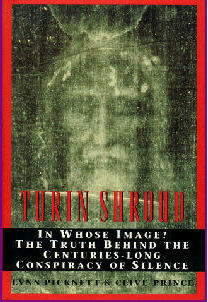 For years opponents of the Shroud's authenticity have been proclaiming
that the image was a painting (McCrone) or a rubbing (Joe Nickell). The
argument of this book presupposes that the image on the Shroud is not a
painting and, in fact, is that of an actual human body: considerable admissions
from the sindonoclast camp. It is a position that concedes that no ancient
artistic technique is known by which the anatomically correct human figure on
the Turin Shroud could have been manufactured. It accepts that the Shroud fits
no medieval artistic genre or style. The Shroud's image is very faint,
superficial (it is known that the image on the Turin Shroud resides only on
the peaks of the fibers) and lacks artists' pigments and brush strokes.
(See Isabel Piczek's article [on his website], "Is The Shroud of Turin a
Painting?", demolishing the notion of the Shroud as a painting.)
For years opponents of the Shroud's authenticity have been proclaiming
that the image was a painting (McCrone) or a rubbing (Joe Nickell). The
argument of this book presupposes that the image on the Shroud is not a
painting and, in fact, is that of an actual human body: considerable admissions
from the sindonoclast camp. It is a position that concedes that no ancient
artistic technique is known by which the anatomically correct human figure on
the Turin Shroud could have been manufactured. It accepts that the Shroud fits
no medieval artistic genre or style. The Shroud's image is very faint,
superficial (it is known that the image on the Turin Shroud resides only on
the peaks of the fibers) and lacks artists' pigments and brush strokes.
(See Isabel Piczek's article [on his website], "Is The Shroud of Turin a
Painting?", demolishing the notion of the Shroud as a painting.)
Written by Lynn Picknett and Clive Prince, the title of this book asks
"In Whose Image?" The authors provide an
answer: Leonardo da Vinci was genius enough to have created it. On this point
it is difficult to disagree, judging from the work of Leonardo and Vasari's
high praise of his genius. Leonardo's notebooks have revealed an incredibly
fertile scientific curiosity and creativity. All would agree in a casual way
that IF anyone could have invented a rudimentary method of photography in the
Renaissance, he is a plausible candidate. They go further: Only Leonardo could
have done it. Other artists are known to have
studied anatomy, experimented with sfumato technique, and, as alchemists, worked
with vegetal and mineral chemicals. The authors' next conclusion is one that
does not follow by the rules of logic or history: Because Leonardo could have
done it, therefore he DID do it. He did it, moreover, not by any method of
conventional art, but by means of photography, and the Shroud is proof of it.
Shroud "politics" aside, Leonardo as author of the Shroud is a wonderfully
exciting, if sensationalist, idea. It draws strength from the science of
radiocarbon (C14) dating, which in 1988 proclaimed, with 95% certainty, that
the Shroud was produced in the late Middle Ages between 1260 and 1390. Sadly
for the premise of his book, Leonardo was not born until 1452 (died 1519).
The C14 labs, however, also reinforce the message of confidence in their dates
by adding that they are 99.9% certain the Shroud was produced between 1000 and
1500, making it chronologically possible for Leonardo to have made it.
Another author says, "Enter Leonardo. Around this time there may have
been great pressure on the
owners of the shroud, the Duke's of Savoy, by the church and its followers to
prove that what they were claiming to be the "cloth of Christ" was authentic,
or at least to let them take a good look at what they had, and determine for
themselves whether or not it was the real deal and not just some cheap mock-up
to fool the masses. If it was the real McCoy as was claimed, then the church
may have wanted to use it as a tool to attract more followers and to convert
the wretched. It is at this point they may have decided they needed to come up
with a cloth that would pass even the closest examination, at least in that
way if it were found to be a forgery, they could save face and at the very
least claim they had been duped also. To pull this off, they knew they would
need the help of somebody who not only had creative qualities but also somebody
with vast scientific knowledge as well. Some one who may not be one hundred
percent on board with all the church was offering at the time. There is only
one person who seems to fit the bill, that being Leonardo da Vinci."
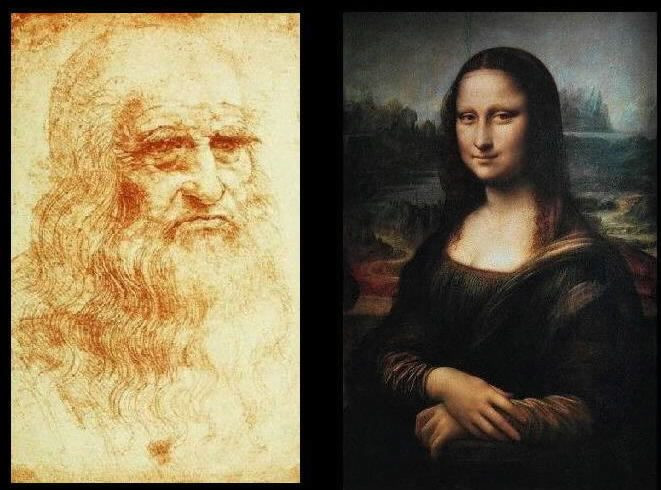 It appears the timing could have fell into place and as my discovery in
"The Last Supper" confirms, the desire and willingness of Leonardo to pull
something over on the church was there, the only things missing are the
connection between Leonardo and the owners of the shroud and the proof that
the technical ability to create such a convincing fake was available at the time.
As it turns out there does appear to be some evidence that a connection did
exist and that Leonardo did have the technical know how. According some of
Leonardo's own writings, found in one of his notebooks believed to have been
written in the 1490's, he makes mention of trips he took where he had visited
the Savoy's. Not only this, but according to historical documents one of his
later employers Guiliano de Medici apparently married a member of the Savoy
family. Also in his notebooks there are detailed drawings and notes on how to
build what Leonardo referred to as a camera obscura. Some experts in the
field of photo imaging believe that by using such a device Leonardo may have
been able to "photograph" or "burn" the image onto the cloth we now know as
the Shroud of Turin. This technique has actually been reproduced with remarkably
similar results. Even the same "errors" that are apparent on the cloth
(the head to small and the rear view being larger than the frontal view)
were all easily reproduced, providing further proof that this was the method
used.
It appears the timing could have fell into place and as my discovery in
"The Last Supper" confirms, the desire and willingness of Leonardo to pull
something over on the church was there, the only things missing are the
connection between Leonardo and the owners of the shroud and the proof that
the technical ability to create such a convincing fake was available at the time.
As it turns out there does appear to be some evidence that a connection did
exist and that Leonardo did have the technical know how. According some of
Leonardo's own writings, found in one of his notebooks believed to have been
written in the 1490's, he makes mention of trips he took where he had visited
the Savoy's. Not only this, but according to historical documents one of his
later employers Guiliano de Medici apparently married a member of the Savoy
family. Also in his notebooks there are detailed drawings and notes on how to
build what Leonardo referred to as a camera obscura. Some experts in the
field of photo imaging believe that by using such a device Leonardo may have
been able to "photograph" or "burn" the image onto the cloth we now know as
the Shroud of Turin. This technique has actually been reproduced with remarkably
similar results. Even the same "errors" that are apparent on the cloth
(the head to small and the rear view being larger than the frontal view)
were all easily reproduced, providing further proof that this was the method
used.
This only leaves one question left to be answered, that being did Leonardo
in some way leave his signature behind? Some sort of mark to state "Leonardo was
here". Knowing now all I have come to know about Leonardo, I am convinced
that this would have been something of great importance to him. Why create a
great masterpiece never to receive the credit for the accomplishment? This fact
leads me to believe there is something more here than meets the eye. Maybe
something in the positioning of the arms or the proportions of the body.
Something that is right in front of our noses if we only knew what it was
we were looking for. Leonardo was a perfectionist to a fault. As I have proven
with The Last Supper, if something looks out of place, Leonardo more likely than
not, meant for it to be out of place. Why are there so many obvious "errors" in
this image? Is Leonardo once again leading us in the direction he has cleverly
mapped out for those willing to follow? Is he once again trying to tell the
story that he had to "hush" when he was alive?
Let's consider the possibilities. Could Leonardo have used the body proportions
from his rendering of the Vitruvian Man as his way of saying "Leonardo was
here".
see
De Vinci
Take note that this person is trying to debunk the theory in the book.
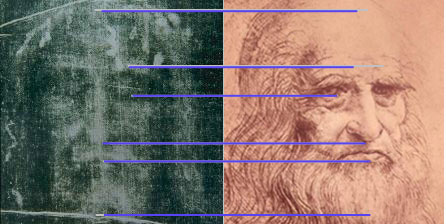 If this is the case, then who is the model for the face? I’ve read a theory
that Leonardo used his own likeness for the face of Jesus on the shroud. To
prove whether this was true or not I decided to use the same technique I used
in comparing the bodies, I compared Leonardo’s only known self-portrait with the
face on the shroud. This made a lot of sense, since it just so happens that
the previous owners of the shroud (the Savoy’s) also owned this portrait.
In fact both works happen to be stored at the same place in Turin. So I was
quite surprised when the comparison came up with negative results. I felt for
certain anybody making such a claim would have already made this same
comparison, but what do I know? Anyhow, that would have been too easy in the
first place and Leonardo was much too clever to be that
conspicuous.
If this is the case, then who is the model for the face? I’ve read a theory
that Leonardo used his own likeness for the face of Jesus on the shroud. To
prove whether this was true or not I decided to use the same technique I used
in comparing the bodies, I compared Leonardo’s only known self-portrait with the
face on the shroud. This made a lot of sense, since it just so happens that
the previous owners of the shroud (the Savoy’s) also owned this portrait.
In fact both works happen to be stored at the same place in Turin. So I was
quite surprised when the comparison came up with negative results. I felt for
certain anybody making such a claim would have already made this same
comparison, but what do I know? Anyhow, that would have been too easy in the
first place and Leonardo was much too clever to be that
conspicuous.
There was one face though, out of the hundreds I tried, that matched
-up almost perfectly with every facial feature visible on the shroud,
the face just so happened to belong to a contemporary of LDV's by the
name of Michelangelo.
Things we know for certain:
1) The image on the cloth was not created from direct contact with
a corpse (or other 3 dimensional objects such as a sculpture or carving)
and the subsequent transfer of oils, sweat, bacteria, or fungus onto its
surface.
Even though, many of theories have centered around this being a
viable solution, and many extensive proposals have been written detailing
exactly how these processes might have taken place, there has yet to be
offered for proof, one convincing demonstration of this effect. This fact
is due to one overwhelming and insurmountable problem, any contact transfer
from a 3 dimensional object onto a 2 dimensional surface is going to
demonstrate what is known as a "global effect". This effect cannot be
overcome no matter how neat and careful a cloth is placed over the
object and makes no difference as to the type of medium used to facilitate
the transfer. This is such a major hurdle that we do not, as much, have
to even take into consideration the other problems that wrapping a
cloth this size, over a dead body, would create. Problems such as,
an abundance of smearing and smudging of blood, bodily excretions,
and burial preparation oils, perfumes and ointments and the inevitable
wrinkling of the cloth, which would leave behind far more distortions
to the final image then can be realistically overlooked. Simply put,
this is not an option and anyone contending otherwise should most
likely stay away from any type of real estate purchases they may be
considering in the near future.
2) The image on the cloth was not created by an internal "burst"
of energy, emanating from a 3 dimensional object, causing superficial
burns of some sort onto the surface of the cloth.
Although the image certainly shows every indication of having been "burned"
onto the cloth, the problem with this theory is as follows, there is no
method by which this energy burst can be focused. There is no reason at
all for this proposed supernatural energy force to radiate only straight
up and straight down, and certainly there is nothing to stop it from going
off in every direction all at once. Yes, objects closer to the cloth would
no doubt, show up stronger, but objects further away would not just appear
fainter, they would appear magnified as well. This is due to the fact
that energy radiating out in every direction, is going to fan out. The
greater the distance between the source and the capturing medium, the
larger and more spread-out the resulting image will be. This would
create an image that is extremely blurry and almost entirely unrecognizable.
Then there is still the same problems as mentioned previously, concerning
the cloth having to be laid out over and around a 3 dimensional object
in an impossibly straight and un-bunched and unwrinkled fashion. Not
something that could be done in a lab environment, much less a small
dark tomb. If this were in fact a divine creation, which is the only
explanation (if we are to believe it to be authentic), left by Christ
as a sort of souvenir in commemoration of his death and resurrection,
then I for one would expect, at the very least, a full color photograph.
Not just some hard to see, easily destroyable, faint negative image on
a piece of flimsy cloth. After all, we are talking about the force that
created the heavens and the earth with all its minute details and
unimaginable vastness. A 3-D hologram would have been a piece of cake
in comparison, so why not something a little more definitive?
3) The image on the cloth was not created by gasses, fumes or vapors
emanating from a decomposing corpse or in combination of that and the
presence of various chemicals placed on the corpse during the burial
preparation process.
This is by far the most unlikely of all the possible solutions
to date. Not only would it be impossible for these gasses and vapors
to be released in a precise, at all focused manner, they would have
a tendency to pool in high spots and also create flow patterns. Then,
once again, there’s still the problem related to a globe effect. This
theory is utterly ridiculous and should have been dispensed of shortly
after its first consideration.
Read the rest...see the link above.
The image was made by a person who was NOT dead.
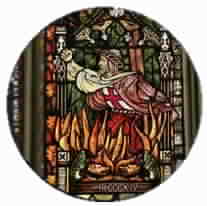 Other researchers say the image on the shroud is Jacques De Molay,
Grand master and the Knight Templar that was burned at the stake by King Philip
of France in 1325AD. The image on
the shroud has been used for centuries as the subject of many paintings
of Jesus when it is not he they look at, it is
DeMolay. Studies of the Shroud of Turin!
The features of de Molay's
body were etched onto the cloth by the lactic acid from the
free-flowing blood, reacting with the frankincense used as a whitening agent,
which was rich in calcium carbonate. DeMolay was not dead when
the shroud was laid over him. It was done to mock the death of Jesus,
which included the placement of a crown of thorns on his head.
Other researchers say the image on the shroud is Jacques De Molay,
Grand master and the Knight Templar that was burned at the stake by King Philip
of France in 1325AD. The image on
the shroud has been used for centuries as the subject of many paintings
of Jesus when it is not he they look at, it is
DeMolay. Studies of the Shroud of Turin!
The features of de Molay's
body were etched onto the cloth by the lactic acid from the
free-flowing blood, reacting with the frankincense used as a whitening agent,
which was rich in calcium carbonate. DeMolay was not dead when
the shroud was laid over him. It was done to mock the death of Jesus,
which included the placement of a crown of thorns on his head.
Carefull study the image. Can you see that it is the image of an 'older'
man? Jacques was 70 years old when this happened. But Leonardo was
this age too. Then look at the image below left, it was created from the actual shroud image
enhancing the face to look like a younger man. The religious
fanatics will do anything to prove their FALSE point about the shroud!
Nobody really knows what Jesus really looked like but we
have a few images to spark your curiosity..
The many faces of Jesus
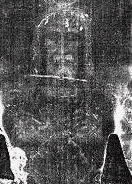 Although historically there is little if any record of exactly how de Molay was tortured,
very shortly after his arrest France's Grand
Inquisitor Guillaume Imbert put him through a blow-by-blow re-enactment
of Jesus's crucifixion. First he was scourged. Then a crown of thorns was thrust on his head.
Then nails were hammered into his wrists and feet, pinning him to 'a roughly assembled cross',
or a large barn door on which he was hung in agony for several
hours. Brought down alive, a knife was then thrust into his side
'not deep enough to cause life-threatening damage but
sufficient to complete the deliberate re-enactment of the
suffering of the 'son of God'.
Although historically there is little if any record of exactly how de Molay was tortured,
very shortly after his arrest France's Grand
Inquisitor Guillaume Imbert put him through a blow-by-blow re-enactment
of Jesus's crucifixion. First he was scourged. Then a crown of thorns was thrust on his head.
Then nails were hammered into his wrists and feet, pinning him to 'a roughly assembled cross',
or a large barn door on which he was hung in agony for several
hours. Brought down alive, a knife was then thrust into his side
'not deep enough to cause life-threatening damage but
sufficient to complete the deliberate re-enactment of the
suffering of the 'son of God'.
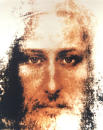 Finally the Grand Inquisitor apparently thought of 'one
more amusing twist' to this scenario.
Finally the Grand Inquisitor apparently thought of 'one
more amusing twist' to this scenario.
[Guillaume Imbert] has de Molay placed on the very burial shroud that Molay used to
mock the Messiah. As the torturers laid him face upwards on the cloth and the excess section is
lifted over his head to cover the front of his body, Imbert cannot resist
a final quotation from the story of the Passion: 'And when Joseph had taken the
body, he wrapped it in a clean linen cloth.' Patting the shroud
around the desperately damaged body,
Imbert suggests that the barely conscious man might care to raise himself,
if he feels as important as the true Christ.
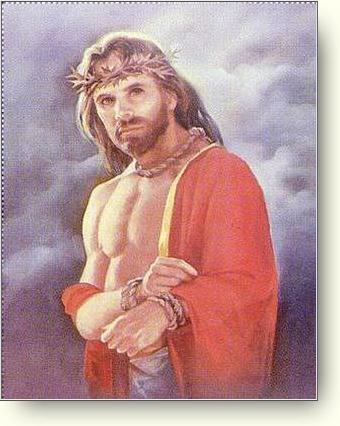 This is how the Turin Shroud was created. This theory proports that its
image is neither of Jesus, nor of Leonardo da Vinci, but of Jacques de Molay -
the Templar Grand Master, who died alongside
the Templar Geoffrey de Charney in 1325. De Molay' was revived
from his crucifixion (necessary because historically he was
publicly burnt at the stake with Geoffrey de Charney),
and then the image-bearing cloth that he had so involuntarily
created:
... travelled ... to the home of Geoffrey de Charney, where it
was washed, folded up, and placed in a drawer. Exactly fifty
years later, in 1357, this fourteen-foot-long
piece of linen was taken out of store and put on public display
in Livey. The long nose, the hair beyond shoulder-length with
a centre parting, the full beard that forked at its base, and
the fit-looking six-foot frame all perfectly match the known
image of the last Grand Master of the Knights Templar. The
Carbon dating found the correct date in the 13th century.
( 1325 was the date Jacques was burned at the stake )
This is how the Turin Shroud was created. This theory proports that its
image is neither of Jesus, nor of Leonardo da Vinci, but of Jacques de Molay -
the Templar Grand Master, who died alongside
the Templar Geoffrey de Charney in 1325. De Molay' was revived
from his crucifixion (necessary because historically he was
publicly burnt at the stake with Geoffrey de Charney),
and then the image-bearing cloth that he had so involuntarily
created:
... travelled ... to the home of Geoffrey de Charney, where it
was washed, folded up, and placed in a drawer. Exactly fifty
years later, in 1357, this fourteen-foot-long
piece of linen was taken out of store and put on public display
in Livey. The long nose, the hair beyond shoulder-length with
a centre parting, the full beard that forked at its base, and
the fit-looking six-foot frame all perfectly match the known
image of the last Grand Master of the Knights Templar. The
Carbon dating found the correct date in the 13th century.
( 1325 was the date Jacques was burned at the stake )
If the image is Not DeMolay it is certainly someone who IS ALIVE.
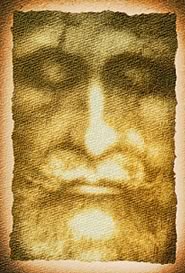 The other side of the 'coin'. "The Pope ordered Geoffrey and his family to remain
perpetually silent on the subject of how the cloth had been acquired and, on that
specific condition, authorized the exhibitions of the Shroud which were held in Lirey
during the 1350's. Geoffrey, ever the perfect knight and obedient servant of king and
Church, would have dutifully complied with the Pope's directive and would have
never publicly spoken of how he had come into possession of the relic, thereby
keeping the information secure among himself, his wife, and their son, Geoffrey II".
The other side of the 'coin'. "The Pope ordered Geoffrey and his family to remain
perpetually silent on the subject of how the cloth had been acquired and, on that
specific condition, authorized the exhibitions of the Shroud which were held in Lirey
during the 1350's. Geoffrey, ever the perfect knight and obedient servant of king and
Church, would have dutifully complied with the Pope's directive and would have
never publicly spoken of how he had come into possession of the relic, thereby
keeping the information secure among himself, his wife, and their son, Geoffrey II".
It has been argued that, for at least one
hundred and fifty years after the Resurrection, the cloth was in the
possession of Carpocratian Gnostics before being brought to Edessa,
during the reign of Abgar the Great (177-212 A.D.), and remained there,
in the possession of Gnostics, for an additional lengthy period.
Was The Shroud In Languedoc During The Missing Years ?
Shroud, by Jack Markwardt
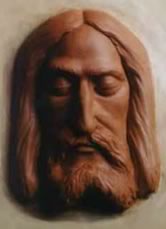 This image is generated by computer using the actual shroud
and its impressions. This is not a young man.
This image is generated by computer using the actual shroud
and its impressions. This is not a young man.
More info on DeMolay from Dryfoo..
JACQUES DE MOLAY -- AN UNKNOWN PAINTING AND ITS STORY
"This thoughts is said to originate from the old secret Society of the
Essene´s from whom they
also is said to have arrived to the Swedish Order of Freemasons through The Knights Templar.
The Perdiction & Prophesy
THE WHOLE OF MANKIND FEAR OF NUMBER 13 AND THE FRIDAY THE 13TH.
The arrest of all Knights Templar and the confiscation of all their properties took place
in France, Friday, 13th October 1307, all over France at the same time, by a circulated secret
order from the King of France, which has influenced on peoples fear for Friday the 13th.
Another reason for the fear of number 13 is the following last statement and prophesy, made by the
Grand Master of the Order of the Knights Templar, Jacques de Molay, in the presence of his
judges, when the flames of the stake reached him and it started burning in his clothes:
"Here you see innocent people die".
"I am calling you, King Philip IV of France ".
"I am calling you, Pope Clemens V".
"I am calling you, Prime Minister Guillaume de Nogaret".
"To appear within one year before the court of GOD to receive
your fair penalty. - Damned, damned, be all your generations -damned until your 13th generation."
Thereafter he felt dead down in the glowing ashes of the stake with the arm and his forefinger
pointing right up to the Heaven of the Almighty God.
The Knights were cleared
of 'devil worship' by Pope Clement over 800 years ago!. Why didn't the Vatican reveal this?
That's Right! So nobody would believe the Knights real story or the Freemasons!
The document called the
Chinon parchment,
reveals for the first time the conspiricy of the church and King Philip to get at the Templar
holdings. The parchment is dated Chinon, 1308 August 17th - 20th and the Vatican keeps
an authentic copy with reference number Archivum Arcis Armarium D 218, the original
having the number D 217. Dr. Barbara Frale found a copy of the parchment in the Vatican
Secret Archives. Frale has published her discoveries in the Journal of Medieval History
and wrote a book on the subject, Il papato e il processo ai templari, 2004. In October 2007,
the Vatican announced that they would release the Chinon Parchment in published form,
after 700 years.
see The actual parchment.
From the parchment; "The French monarchy reacted by triggering a true blackmail
mechanism, which then urged Clement V to reach the ambiguous compromise ratified during
the Council of Vienne in 1312: unable to oppose himself to the will of the King of France, Phillip
the Fair, who imposed the elimination of the Templars, the pope removed the order from the
reality of that period, without condemning or abolishing it, but isolating it in a sort of
“hibernation”, thanks to a clever device of the canon law. After explicitly
declaring that the trial did not prove the charge of heresy, Clement V suspended the
Templar Order by means of a non definitive sentence, imposed by the necessity to avoid a
serious danger to the Church that banned them, under penalty of excommunication, to use
such name or their distinctive symbols."
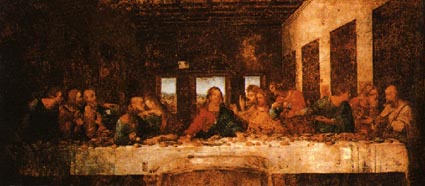 This sign is used by Leonardo da Vinci in his big
painting of the Holy Communion in the St. Marie dele Grazie in
Milan, Italy. In this painting, as illustrated below, the Marshal
of the Castle of the Knights Templar, is also doing the same
sign to the Highest, Almighty Judge of Justice. The Holy
Communion painting is based on a statement of Jesus: One of you
shall betray me". - This painting, as illustrated, is based on a
similar statement: "We are innocent". The people of Paris thought
that this prediction also had power on them and their coming
relatives and therefore this fear for the number 13 started
spreading all over the world, also when the French emigrants
took it with them to the new country, USA. - But the prediction
was not directed to them and not valid for them. Just for the
King of France, the Pope and the Pime Minister and their future
families in thirteen generations.
This sign is used by Leonardo da Vinci in his big
painting of the Holy Communion in the St. Marie dele Grazie in
Milan, Italy. In this painting, as illustrated below, the Marshal
of the Castle of the Knights Templar, is also doing the same
sign to the Highest, Almighty Judge of Justice. The Holy
Communion painting is based on a statement of Jesus: One of you
shall betray me". - This painting, as illustrated, is based on a
similar statement: "We are innocent". The people of Paris thought
that this prediction also had power on them and their coming
relatives and therefore this fear for the number 13 started
spreading all over the world, also when the French emigrants
took it with them to the new country, USA. - But the prediction
was not directed to them and not valid for them. Just for the
King of France, the Pope and the Pime Minister and their future
families in thirteen generations.
The King felt down from his horse and died before the year was
through. The Pope got an intestinal obstruction and died before the
year was through and the Prime Minister hanged himself before the year
was through. Their families are reported to have lived unhappy.
This prediction or prophesyon the flames, just before the physical
life burned out, was not a physical judgment, legislated by
governmental or religious official judges, but a spiritual, heavenly
prophesy that could only reach fulfilment if it was true and correct
that the Order was innocent. This is the fantastic, incorruptible law
of God, having its ground stone in 1 Cor 14:1, and it can be referred
too when it comes to the innocence of the banned Knights Templar . If
such a prediction or prophesy is not true and correct, which in the
Grand Master's case means innocence it will incorruptibly turn back to
the sender and be valid for the sender, not only in this lifetime but
also in the next. The author of this paper can understand spiritually
that the Grand Master owned the gift of prophesy as per 1 Cor 14:1. As
his prediction or prophesy was fulfilled, proves the innocence.
Otherwise the prophesy should have hade no effect on the three persons
and their families, involved. This is for the author the spiritual
proof of the innocence of the Order that can be confirmed by
God-conscious people. No other physical claim can be regarded as so
important as this spiritually incorruptible law of God. Physical
proves but denied, a guilt declaration under physical torture, now in
our age regarded as a crime against human rights, power or bans by
human officials, has no effect at all on the law of God. This is the
knowledge that the Knight Templars left to us succeeding Christian
generations and Freemason Brothers to try to understand. Their
declared innocence, bid of defiance despite of death penalty can also
be compared withMatt 16:19as to the guilt of the official judges, who
paid the penalty partly in this lifetime, by loss of the physical
life. This spiritual law from Jesus is also called the law of karma in
other religions, and it is claimed by many researchers that the
Knights Templar learned to understand this law during their stay in
Jerusalem.
The gift of prophesy and its dangerous, incorruptible consequences if
misused, might change the history of the Knights Templar positively in
the future.
"The Grand Master of the Order proved the power of the thoughts by
lifting the arm from the red-hot ashes giving the forefinger sign up
to the Kingdom of the Almighty God. It proves to the author of this
paper that the Order was loyal and faithful to the Church and with a
spiritual consciousness, higher then the official leaders of the time
regarding the innocent Master, to whose memory and protection the
Order was founded and individual Monk-oath sworn, namely Jesus from
Nazareth."
Another secret book
Johannes of Jerusalem; Fragment from the study of spherical
oscillations and different forms of the energy
(this fragment proven that Johnannes of Jerusalem with the
atlantidischen Aubacca generator was familiar and with it exact
data concerning the individual parts of this energy production
plant and its functioning are.)
Translated from the Latin original text:
There are three kinds of forces, which move everything:
the tellurische, the astrale and the cosmos through-breaking.
These three generate that age-old energy, which the Atlantiden
Aubacca called, in equal parts as pulsating wave. This was
well-known the priests of Atlantis without each doubt. While
many years have they, by using a cave as it were as source,
this energy produces and the 23 cities supplied.
After the invention of the Rades many Atlantiden succumbed to
the travel fever and the Aubacca energy fallow from the cave out
and destroyed them. Therefore Atlantis sank also in the ocean.
The cave was as it were a furnace. In it there were six oblong
more?Eier? of a diameter of **** one?? high golden? Truhe?******
durch (or: in) eine(r) metallic?Brandung? (?Aufwallung??) ***
rhythmically in a Intervall***fuenf foot on the left of waves
***(German web site)
"It is claimed that this book, known of very few, (one
confiscated copy, from the Order of Knights Templar property, is
claimed to be stocked in the Vatican), become one of the reasons for
the ban of the Knights Templar as Johannes of Jerusalem here, before
Nostradamus, predicted in prophecy about the centre of the world, to be
opposite to the opinion of the Church at the time".
What we derived from this is that the church changed it's opinion
on this religion ( true followers of Christ ) sometime between
the 3rd century AD and the legal existance of the knights and
the execution of them. As noted by the prophecy of Nostradamus,
there was a difference of opinion. What we also see is that
the Essenes had much to do with the original belief of the
Knights and true 'secret' life of Jesus. The 'difference of
opinion' is what leads us to the writing of this page and the
others we have presented. We suspect
that the 'book' held in the Vatican Library contains a secret
that will destroy the church at it's very roots.

Esotericism
In Judaic type mysticism, taking the form of a
search for God and an experience of divinity, esotericism is
fundamentally based upon the law of correspondence
with the objective of finding symbolic
relations between the divine and the earthly, the transcendent
and the immanent, the visible and the invisible, man and the
universe, through the use of analogies. The passage from one
dimension to another takes the form of initiation ceremonies,
simulations and magic type rituals in which a neophyte is given
the secret of transmutation, agrees to be a member of the group
of his fellows and gains access to a higher spiritual level.

Many are wondering, "What is a LOGOS"
PHILO JUDAEUS, also Philo of Alexandria (c. 20 BC-AD 50),
Jewish-Hellenistic philosopher; although considered the greatest Jewish
philosopher of his age, he appropriated so completely the
doctrines of Greek philosophy that he must be considered also a
Greek philosopher who combined the elements
borrowed from various sources into an original unity.
Philo was born in Alexandria, Egypt, to a wealthy, aristocratic
Jewish family and received a thorough education in the Old
Testament and in Greek literature and philosophy. He had an
intimate knowledge of the works of Homer and of the Greek
tragedians, but his chief studies were in Greek philosophy,
especially the teachings of the Pythagoreans, Plato, and the
Stoics.
To Philo the divinity of the Jewish law was the basis and test of all
true philosophy. He maintained that the greater part of the Pentateuch,
in both its historical and legal portions, could be explained
allegorically, and that its deepest and truest significance is to be
found through such interpretation. He conceived of God as a being
without attributes, better than virtue and knowledge,
better than the beautiful and the good,
a being so exalted above the world that an intermediate class of
beings is required to establish a point of contact between him
and the world. These beings he found in the spiritual
world of ideas-not merely ideas in the
Platonic sense, but real, active powers, surrounding God as a number of
attendant beings. All these intermediate powers are known as the Logos,
the divine image in which persons are created and through
which they participate in the deity.
An individual's duties consist of veneration of God and love and
righteousness toward others. Humans are immortal by reason of
their heavenly nature, but just as degrees in this divine
nature exist, degrees of immortality also exist.
Mere living after death, common to all humanity, differs
from the future existence of the perfect souls, for
whom paradise is oneness with God.
Many of the numerous extant works of Philo are concerned with
the exposition and allegorical interpretation of Genesis and with
the exposition of the Law of Moses for Gentiles.
His other writings include biographies
of biblical characters and a series of works on the Ten Commandments.
The selection below describes the pre-Christian ascetics of Egypt.
lt is important because it shows that asceticism was common in the deserts
of Egypt even before the Christian monks and thus by no means
peculiarly Christian.
Philo
Pagan and Christian Gnostics call the one consciousness in
all of us 'The Logos'. The Gospel of John equates Jesus with the
Logos that is 'the true light which illuminates everyone who comes
into the world'. Hermes Trimegistus explains;
'That in you which sees and hears is the Logos of the Lord. It
is the Consciousness of God the Father'.
"The Word"
"IN the beginning was the Word, and the Word was
with God, and the Word was God." (John i. 1.) The doctrine
of the divine creative word (from the Greek Logos) appears to
have been coeval in its origin with
that of the Trinity, if not inseparably connected with it, as it
constitutes the second member of the Trinity of "Father, Word,
and Holy Ghost" in most of the ancient systems of religion.
Works on heathen mythology show that it
was anciently a very prevalent custom to personify ideas,
thoughts and words into angels and Gods. Words were first
personated, and transformed into men, then into angels,
and finally into Gods.
And here is foreshadowed the origin of John's
personification of "the Word made flesh." It was simply the
word of the supreme God as it escaped from his mouth,
assuming the form and characteristics of a divine
being like himself, and taking position as a secondary
God and second member of the Trinity. This was the orient
conception, and it appears to have been John's.
He evidently had no thought of Christ experiencing human birth,
at first, or being born of a woman, but believed, like some of
the orientalists, that he came out of the mouth of the Father,
and was thus "made flesh." (John i. 2.) Not a word of
Christ being born is found in John's Gospel,
not until after his existence, is the 'Word' spoken of.
John also represents the Word as having been the Creator.
"All things were made by him." (John i. 3.) And Peter declares,
"By the word of God the heavens were of old." (2 iii. 5.)
Now, let it be observed here,
as a notable circumstance, that the Chinese bible, much older than the
Christian's New Testament, likewise declares, "God pronounced the
primeval Word, and his own eternal and glorious abode sprang into existence.
" Mr. Guizot, in a note on Gibbon's work, says, "According to the
Zend-Avesta (the Persian bible, more than three thousand years old),
it is by the Word, more ancient than the world,
that Ormuzd created the universe."
In like manner the sacred writings of the ancient Tibetans
speak of "the Word which produced the world" -- an exact counterpart
to John's declaration, "All things were made by him."
And the ancient Greek writer
Amelias speaking of the God Mercury, says, "And this plainly was the
Logos (the Word), by whom all things were made, he being
himself eternal, as Heraclitus would say, ...
He assumed to be with God, and to be God, and in him everything that was
made, has its life and being, who, descending into body, and putting on
flesh, took the appearance of a man, though still
retaining the majesty of his nature. Here is "the Word made flesh"
set forth in most explicit terms. The Psalmist exclaims, "By the Word
of God were the heavens made, and all the host of them by the Breath of his mouth."
(Ps. xxxiii. 6.) Here is disclosed not only the conception of the Word
as Creator, but also the Word and the Breath as synonymous terms, both
of which conceptions oriental history amply proves to be of
heathen derivation.
It was anciently believed that the Word and Breath of God were
the same, and possessed a vitalizing power, which, as they issued from his
mouth, might be transformed into another being known
as a secondary God. Both the Jews and
the Christians seem to have inherited this belief, as evinced by the
foregoing quotations from their bible. The most ancient tradition taught
that the Word emanated from the mouth of the principal God, and "became flesh,"
that is, took form, as the ancient Brahmins expressed it, for the special
purpose of serving as agent in the work of creation, that is, to become the
creator of the external universe. St. John evidently borrowed this idea.
Read his first chapter.
The pre-existence or previous existence of the Word, antecedent
to the date of its metamorphosis into the human form, we find taught
in several of the ancient systems of religion,
as well as the more modern Christian system.
Several texts in the Christian New Testament set forth the doctrine
quite explicitly. Christ, as the Divine Word, declared, "Before Abraham
was I am," and that he had an existence with the Father before the
foundation of the world, etc.,
which is a distinct avowal of the doctrine of preexistence.
But oriental history proves the doctrine is much older
than Christianity.
The Hindo very anciently taught that "the Word had existed with
God from all eternity, and when spoken it became a glorious form,
the aggregate embodiment of all the divine ideas, and performed
the work of creation." And of Chrishna,
it is affirmed that "while upon the earth he
existed also in heaven." (See Baghavat Gita.)
In like manner it is declared of an Egyptian God, that
"though he was born into the world, he existed with his father
God before the world was made." And parallel to this
is the statement of the Chinese bible,
that "though the Holy Word (Chang-si) will be born upon the
earth, yet he existed before anything was made." Even
for Pythagoras it was claimed he existed in heaven before
he was born upon the earth. Mr. Higgins,
in summing up the matter, declares, "All the old religions
believed the world was created by the Word, and that this Word
existed before creation" (Ana., vol. ii. p. 77), which clearly
indicates the source of St. John's creative Word.
In most cases the living Divine Word
was known by different names and titles, prior to the era of its
assuming the mortal form, from that by which it was known after
its fleshly investment.
Among the ancient Persians, the name for the divine spiritual
Word was Hanover. After its human birth, it was called
Mithra
the Mediator." The Hindoo oriental term for the primeval
Word was Om, or Aum. After assuming
its most important incarnate form, it was known as Chrishna.
The Chinese Holy Interior Word was Omi-to, and its
principal incarnation was Chang-ti or Ti-enti.
The Japanese also proclaimed their belief in a Divine Word before the
Christian era, which, in their language, was Amina.
They taught, like John, that it came forth from the mouth of the
Supreme God (Brahm) to perform the work of creation, after which,
it was known as Sakia. And that popular Christian
writer, Mr. Milman, informs us that the
Jewish founders of Christianity believed in an original Divine Word,
which they call Memra. When it descended to the earth, and "became flesh,
and dwelt amongst us" (John i. 4.) according to the evangelist John,
it was known as Jesus Christ. Mr. Milman states also,
that "the appellation to the Word is found in the Indian (Hindoo),
Persian, the Platonic, and the Alexandrian systems."
(Hist. of Chr., Book I., Chap. 2.)
"The Word." "the Holy Word," "the Divine Word," etc., are terms now
frequently applied to the Christian bible, without any suspicion of their
heathen origin. The Zend-Avesta, the Persian bible,
was always called "The Living Word of God,"
for that is the meaning of the term Zend-Avesta, and the oldest bible in
the world is the Vedas, and it means both Word and Wisdom. Om, the Egyptian's
Holy Word, they frequently applied both to their
incarnate Gods and to their sacred writings.
The practice of calling bibles "The Word of God" originated from the belief that,
when the incarnate 'Word' left the earth and returned to heaven, he infused
a portion of his living spirits into the divine writings
which contained his history and his doctrines,
and which be himself had prompted his disciples to write as his "Last Revelation
to man." They then must contain a portion of him, i.e., a portion of the Holy Word
-- hence, both were called "The Holy Word."
And this heathen custom Christians borrowed.
The motive which prompted a belief in the creative Word may be styled
a theological necessity. It was believed that the principal God, like the
rulers of earth, was too aristocratic to labor with his own hands.
Hence, another God was originated to perform the work of creation,
and called "The Word."
Continued on Shroud page 2

Search this site
Our search Engine does not search for the links in this site,
only words in the text.
NO PART OF THIS SITE MAY BE COPIED OR REPRODUCED,
IN WHOLE OR IN PART WITHOUT THE EXPRESS WRITTEN APPROVAL OF
THE WEBMASTER...© COPYRIGHT 1999 - 2009 C.I.C. All Rights Reserved
This page has been visited
Times since August 27th, 1999